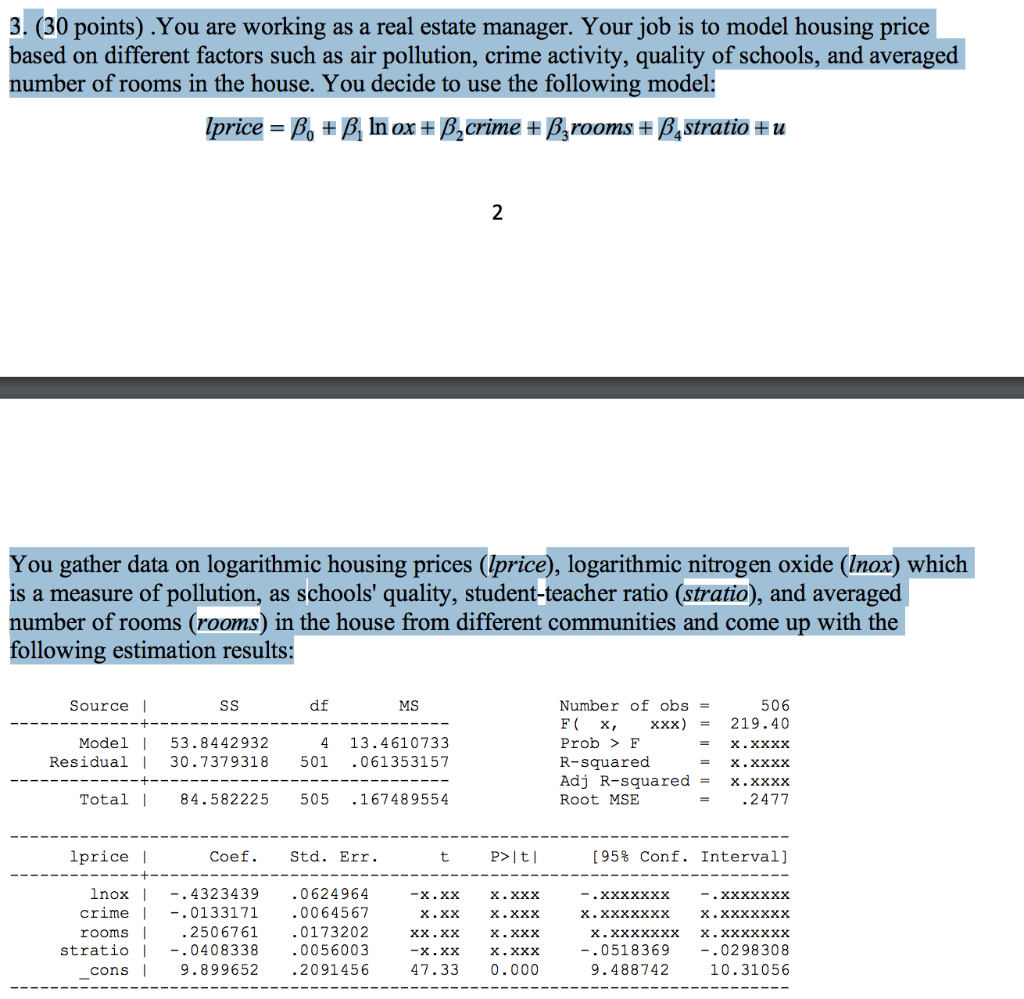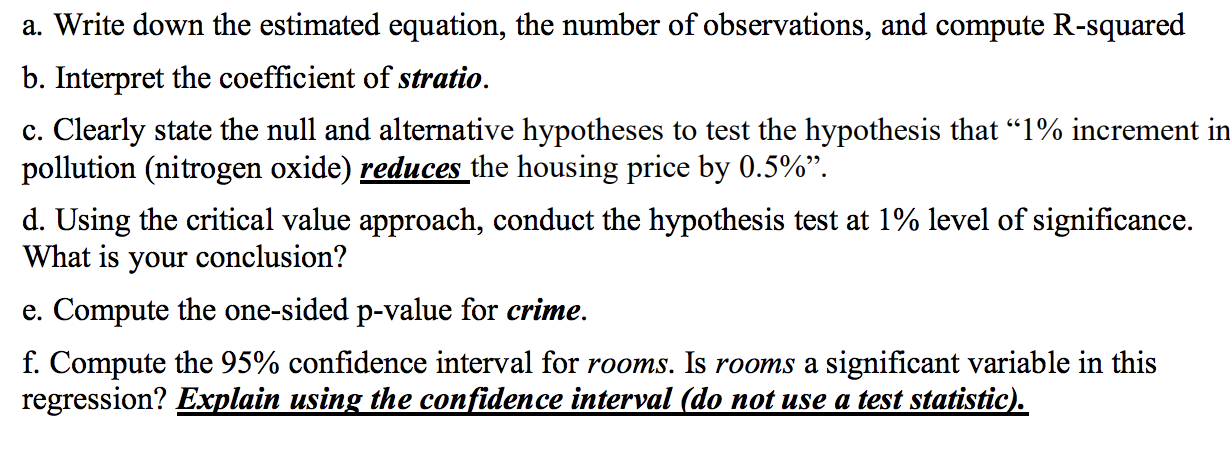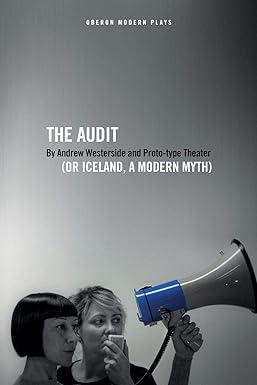
 3. (30 points) .You are working as a real estate manager. Your job is to model housing price based on different factors such as air pollution, crime activity, quality of schools, and averaged number of rooms in the house. You decide to use the following model: lprice = 0 + 1 ln ox + 2 crime + 3 rooms + 4 stratio + u 3 You gather data on logarithmic housing prices (lprice), logarithmic nitrogen oxide (lnox) which is a measure of pollution, as schools' quality, student-teacher ratio (stratio), and averaged number of rooms (rooms) in the house from different communities and come up with the following estimation results:a. Write down the estimated equation, the number of observations, and compute R-squared b. Interpret the coefficient of stratio. c. Clearly state the null and alternative hypotheses to test the hypothesis that 1% increment in pollution (nitrogen oxide) reduces the housing price by 0.5%. d. Using the critical value approach, conduct the hypothesis test at 1% level of significance. What is your conclusion? e. Compute the one-sided p-value for crime. f. Compute the 95% confidence interval for rooms. Is rooms a significant variable in this regression? Explain using the confidence interval (do not use a test statistic).
3. (30 points) .You are working as a real estate manager. Your job is to model housing price based on different factors such as air pollution, crime activity, quality of schools, and averaged number of rooms in the house. You decide to use the following model: lprice = 0 + 1 ln ox + 2 crime + 3 rooms + 4 stratio + u 3 You gather data on logarithmic housing prices (lprice), logarithmic nitrogen oxide (lnox) which is a measure of pollution, as schools' quality, student-teacher ratio (stratio), and averaged number of rooms (rooms) in the house from different communities and come up with the following estimation results:a. Write down the estimated equation, the number of observations, and compute R-squared b. Interpret the coefficient of stratio. c. Clearly state the null and alternative hypotheses to test the hypothesis that 1% increment in pollution (nitrogen oxide) reduces the housing price by 0.5%. d. Using the critical value approach, conduct the hypothesis test at 1% level of significance. What is your conclusion? e. Compute the one-sided p-value for crime. f. Compute the 95% confidence interval for rooms. Is rooms a significant variable in this regression? Explain using the confidence interval (do not use a test statistic).
3. (30 points). You are working as a real estate manager. Your job is to model housing price based on different factors such as air pollution, crime activity, quality of schools, and averaged number of rooms in the house. You decide to use the following model: Iprice = B. + B, In ox B crime + B rooms + B,stratio Eu 2 You gather data on logarithmic housing prices (lprice), logarithmic nitrogen oxide (Inox) which is a measure of pollution, as schools' quality, student-teacher ratio (stratio), and averaged number of rooms (rooms) in the house from different communities and come up with the following estimation results: Source SS df MS 4. Model 1 Residual 53.8442932 30.7379318 13.4610733 .061353157 Number of obs = FC X, xxx) = Prob > F R-squared Adj R-squared = Root MSE 506 219.40 X.XXXX X.XXXX X.XXXX .2477 501 Total 1 84.582225 505 .167489554 lprice Coef. Std. Err. t P>t! [95% Conf. Interval] Inox crime rooms stratio cons 4323439 -.0133171 2506761 -.0408338 9.899652 .0624964 .0064567 0173202 .0056003 .2091456 -X.XX X.XX XX.XX -X.XX 47.33 x.xxx X.XXX X.XXX X.XXX 0.000 -.xxxxxxx x.xxxxxxx X.XXXXXXX - .0518369 9.488742 -.XXXXXXX X.XXXXXXX x.xxxxxxx -.0298308 10.31056 a. Write down the estimated equation, the number of observations, and compute R-squared b. Interpret the coefficient of stratio. c. Clearly state the null and alternative hypotheses to test the hypothesis that 1% increment in pollution (nitrogen oxide) reduces the housing price by 0.5%. d. Using the critical value approach, conduct the hypothesis test at 1% level of significance. What is your conclusion? e. Compute the one-sided p-value for crime. f. Compute the 95% confidence interval for rooms. Is rooms a significant variable in this regression? Explain using the confidence interval (do not use a test statistic). 3. (30 points). You are working as a real estate manager. Your job is to model housing price based on different factors such as air pollution, crime activity, quality of schools, and averaged number of rooms in the house. You decide to use the following model: Iprice = B. + B, In ox B crime + B rooms + B,stratio Eu 2 You gather data on logarithmic housing prices (lprice), logarithmic nitrogen oxide (Inox) which is a measure of pollution, as schools' quality, student-teacher ratio (stratio), and averaged number of rooms (rooms) in the house from different communities and come up with the following estimation results: Source SS df MS 4. Model 1 Residual 53.8442932 30.7379318 13.4610733 .061353157 Number of obs = FC X, xxx) = Prob > F R-squared Adj R-squared = Root MSE 506 219.40 X.XXXX X.XXXX X.XXXX .2477 501 Total 1 84.582225 505 .167489554 lprice Coef. Std. Err. t P>t! [95% Conf. Interval] Inox crime rooms stratio cons 4323439 -.0133171 2506761 -.0408338 9.899652 .0624964 .0064567 0173202 .0056003 .2091456 -X.XX X.XX XX.XX -X.XX 47.33 x.xxx X.XXX X.XXX X.XXX 0.000 -.xxxxxxx x.xxxxxxx X.XXXXXXX - .0518369 9.488742 -.XXXXXXX X.XXXXXXX x.xxxxxxx -.0298308 10.31056 a. Write down the estimated equation, the number of observations, and compute R-squared b. Interpret the coefficient of stratio. c. Clearly state the null and alternative hypotheses to test the hypothesis that 1% increment in pollution (nitrogen oxide) reduces the housing price by 0.5%. d. Using the critical value approach, conduct the hypothesis test at 1% level of significance. What is your conclusion? e. Compute the one-sided p-value for crime. f. Compute the 95% confidence interval for rooms. Is rooms a significant variable in this regression? Explain using the confidence interval (do not use a test statistic)

 3. (30 points) .You are working as a real estate manager. Your job is to model housing price based on different factors such as air pollution, crime activity, quality of schools, and averaged number of rooms in the house. You decide to use the following model: lprice = 0 + 1 ln ox + 2 crime + 3 rooms + 4 stratio + u 3 You gather data on logarithmic housing prices (lprice), logarithmic nitrogen oxide (lnox) which is a measure of pollution, as schools' quality, student-teacher ratio (stratio), and averaged number of rooms (rooms) in the house from different communities and come up with the following estimation results:a. Write down the estimated equation, the number of observations, and compute R-squared b. Interpret the coefficient of stratio. c. Clearly state the null and alternative hypotheses to test the hypothesis that 1% increment in pollution (nitrogen oxide) reduces the housing price by 0.5%. d. Using the critical value approach, conduct the hypothesis test at 1% level of significance. What is your conclusion? e. Compute the one-sided p-value for crime. f. Compute the 95% confidence interval for rooms. Is rooms a significant variable in this regression? Explain using the confidence interval (do not use a test statistic).
3. (30 points) .You are working as a real estate manager. Your job is to model housing price based on different factors such as air pollution, crime activity, quality of schools, and averaged number of rooms in the house. You decide to use the following model: lprice = 0 + 1 ln ox + 2 crime + 3 rooms + 4 stratio + u 3 You gather data on logarithmic housing prices (lprice), logarithmic nitrogen oxide (lnox) which is a measure of pollution, as schools' quality, student-teacher ratio (stratio), and averaged number of rooms (rooms) in the house from different communities and come up with the following estimation results:a. Write down the estimated equation, the number of observations, and compute R-squared b. Interpret the coefficient of stratio. c. Clearly state the null and alternative hypotheses to test the hypothesis that 1% increment in pollution (nitrogen oxide) reduces the housing price by 0.5%. d. Using the critical value approach, conduct the hypothesis test at 1% level of significance. What is your conclusion? e. Compute the one-sided p-value for crime. f. Compute the 95% confidence interval for rooms. Is rooms a significant variable in this regression? Explain using the confidence interval (do not use a test statistic).





